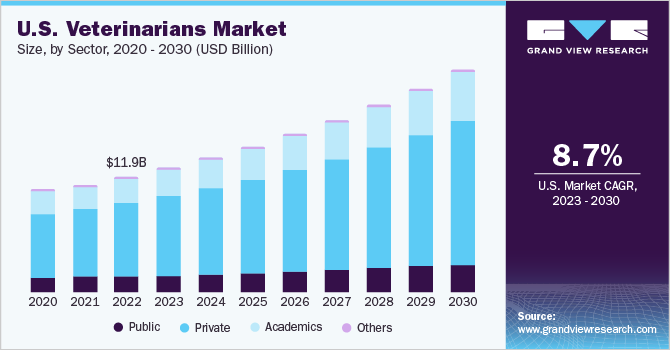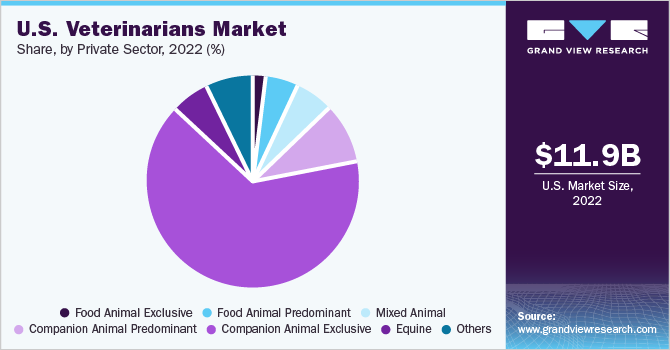- Home
- »
- Animal Health
- »
-
U.S. Veterinarians Market Size, Share & Trends Report, 2030GVR Report cover
![U.S. Veterinarians Market Size, Share & Trends Report]()
U.S. Veterinarians Market Size, Share & Trends Analysis Report By Sector (Public, Private, Academics, Others), And Segment Forecasts, 2023 - 2030
- Report ID: GVR-4-68039-431-1
- Number of Report Pages: 100
- Format: PDF, Horizon Databook
- Historical Range: 2018 - 2021
- Forecast Period: 2023 - 2030
- Industry: Healthcare
Report Overview
The U.S. veterinarians market size was valued at USD 11.92 billion in 2022 and is expected to grow at a compound annual growth rate (CAGR) of 8.7% from 2023 to 2030. The growing animal population, uptake of pet insurance, and expenditure on the well-being of pets are the key market drivers. The demand for veterinary professionals is poised to increase in coming years, as the retirement of existing ones is due. For instance, according to an article published by American Animal Hospital Association in October 2022, each year, over 2,000 veterinarians from the baby boomer generation retire. While this is going on, the number of veterinarians in the U.S. is only growing by 2.7% yearly, with 2,600 new vets graduating from veterinary colleges each year.

The COVID-19 pandemic resulted in a fall in the number of veterinary visits, practice revenue, and disruption in veterinary care delivery during the first few months of 2020. In March 2020, the U.S. FDA relaxed restrictions on veterinary telemedicine practices. As per new guidelines, veterinarian-client-patient relationship requirements were temporarily suspended. Veterinarians were also allowed to prescribe extra-label drugs and veterinary feed directive drugs after a remote examination & diagnosis of animals.
Various public, regulatory, nonprofit, and private health institutions released guidelines to ensure continuity of care for animals during the pandemic. These included AVMA, FDA, and CDC. The CDC, for instance, released interim guidelines for the prevention and control of infection for veterinary clinics treating pets during the pandemic.
The veterinary services sector had been facing retention challenges for a long time as a result of the emotional toll of work and intense work hours. The rise in demand for veterinary services during the pandemic highlighted the crucial need for a greater number of skilled veterinarians. The pandemic also exacerbated workflow burdens, as many patient visits were either deferred or canceled during the first half of 2020, thus creating a backlog when services resumed.
The loss of staff members due to sickness or burnout is estimated to have further contributed to demand for veterinarians across the U.S., to ensure continued provision of quality patient care. This demand is estimated to continue post-COVID. The pandemic escalated the digitalization of veterinary care as veterinarians began adopting telemedicine to ensure business continuity while following social distancing norms.
Supportive initiatives undertaken by the government are expected to facilitate the growth of the market in the coming years. For instance, the Veterinary Services Grant Program is intended to support veterinary services and veterinarian shortage situations. It comprises 2 types of grants. These include the Rural Practice Enhancement (RPE) grants and Education, Extension, and Training (EET) grants.
During FY 2021, about 3 million funds were distributed to the selected grant applicants. Some of the initiatives funded by the program in 2021 include the Iowa State University’s expansion of rural veterinary practice in organic and non-conventional livestock through continuing education, and the Virginia Polytechnic Institute & State University’s ‘Training the Veterinary Public Practitioner’ project.
Sector Insights
By sector, the private segment held the largest revenue share of the U.S. veterinarians market in 2022. This is owing to a large number of veterinarians engaged in private clinical practice, driven by high demand and ROI. Private practitioners, however, must be licensed by respective states to practice and are mainly involved in the diagnosis & treatment of diseases, disorders, or injuries in animals. They also provide preventive medicine to help animals avoid diseases and maintain health.
Private veterinarians typically work with technicians, technologists, assistants, and laboratory animal caretakers to diagnose, examine, & treat animals. They work in veterinarians’ offices & clinics, animal hospitals, and veterinary testing laboratories. Over 90% of patients at companion animal exclusive veterinary practices are pets. This contributed to the dominant share of the companion animal exclusive segment in the private sector in 2022.

The demand for quality & affordable pet care is anticipated to increase over time, owing to the rise in the prevalence of chronic diseases, awareness about pet health, adoption of pet insurance, and expenditure on pet diagnostics & treatments. For instance, according to APPA, in the U.S., individuals spent over $136.8 billion on pets of all kinds in 2022. In addition, $35.9 billion was spent on product sales and veterinary care.
The others segment comprising veterinarians working with nonprofit organizations as care providers, researchers, or consultants is anticipated to grow at the fastest rate in the near future. Nonprofit organizations include humane organizations, professional societies, charitable organizations, missionaries, zoos or aquariums, and wildlife services. The rise in the number of charities and nonprofit organizations in the U.S. is estimated to fuel the segment’s growth. The United States has 44,391 animal organizations.
U.S. Veterinarians Market Report Scope
Report Attribute
Details
Revenue forecast in 2030
USD 23.31 billion
Growth rate
CAGR of 8.7% from 2023 to 2030
Base year for estimation
2022
Historical data
2018 - 2021
Forecast period
2023 - 2030
Quantitative units
Revenue in USD million & CAGR from 2023 to 2030
Report coverage
Revenue forecast, company ranking, competitive landscape, growth factors, and trends
Segments covered
Sector
Customization scope
Free report customization (equivalent up to 8 analysts’ working days) with purchase. Addition or alteration to country & segment scope.
Pricing and purchase options
Avail customized purchase options to meet your exact research needs. Explore purchase options
U.S. Veterinarians Market Report Segmentation
This report forecasts revenue growth at the country level and provides an analysis of the latest industry trends and opportunities in each of the sub-segments from 2018 to 2030. For this report, Grand View Research has segmented the U.S. veterinarians market report based on sector:
-
Sector Outlook (Revenue, USD Million, 2018 - 2030)
-
Public
-
Private
-
Food Animal Exclusive
-
Food Animal Predominant
-
Mixed Animal
-
Companion Animal Predominant
-
Companion Animal Exclusive
-
Equine
-
Others
-
-
Academics
-
Others
-
Frequently Asked Questions About This Report
b. The U.S. veterinarians market size was estimated at USD 11.92 billion in 2022 and is expected to reach USD 12.89 billion in 2023.
b. The U.S. veterinarians market is expected to grow at a compound annual growth rate of 8.7% from 2023 to 2030 to reach USD 23.31 billion by 2030.
b. The private segment dominated the U.S. veterinarians market with a share of over 64% in 2022. This is owing to a large number of veterinarians engaged in private clinical practice driven by high demand and ROI.
b. The U.S. veterinarians market has been segmented on the basis of the sector. The sector segment comprises public, private, academics, and others.
b. Key factors that are driving the U.S. veterinarians market growth include the growing animal population, uptake of pet insurance, and expenditure on the well-being of pets.
Share this report with your colleague or friend.
![gvr icn]()
NEED A CUSTOM REPORT?
We can customize every report - free of charge - including purchasing stand-alone sections or country-level reports, as well as offer affordable discounts for start-ups & universities. Contact us now
![Certified Icon]()
We are GDPR and CCPA compliant! Your transaction & personal information is safe and secure. For more details, please read our privacy policy.
We are committed towards customer satisfaction, and quality service.
"The quality of research they have done for us has been excellent."





